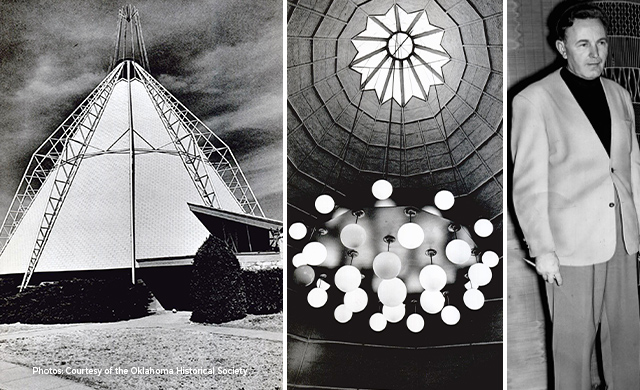Architectural Milestone Reborn

West Edmond is home to the most unusual church building in America, a small, teepee-shaped structure that emanates a sense of quirkiness and an air of abandonment. The story of this stone and steel building rivals that of many mega-movie stars: humble beginnings, eventual world fame, slow deterioration and a surprising comeback!
Humble Beginnings
In 1947, the growing Hopewell Baptist Church needed a bigger structure. The congregation reached out to the University of Oklahoma, hoping an architectural student might create a design inexpensively. A simple cement block structure would do, the committee said, and structural steel frames from the West Edmond oil field were plentiful.
Bruce Goff, the architecture professor, was captivated by the idea of incorporating the oil field frames. His emerging philosophy of design, inspired by Frank Lloyd Wright, was to use organic materials harmoniously with the environment. Goff paired with a student to create a design paying homage to the state’s petroleum history and to the Native Americans who once lived on the land.
The congregation was frankly baffled by the unusual design, but after it grew on them, they built it. This labor of love took four years, voluntarily constructed by the church members. The men, mostly farmers and oil field workers, built the church in the evenings, while the women provided nightly potluck meals. The church’s stone was quarried locally, the shingles were Oklahoma red clay, and oil field trusses supported the structure. Once completed, the twelve-sided church was 90-feet tall and held 400 people.
Eventual World Fame
In the 1950s, no one knew Bruce Goff would become Oklahoma’s preeminent architect of the era—but the building certainly captured worldwide attention. Modern-day architect, Hans Butzer, known for designing the Oklahoma City National Memorial and the Skydance Bridge over I-40 with his wife Torrey, said, “Goff resourcefully delivered a worship space of minimal means, and yet the beautiful lantern top leads our eyes toward the heavens, suggesting a greater power above.”
Slow Decline
Despite the church’s fame, the top leaked and the bottom flooded. The temperature was never quite comfortable, either. In the 1970s, the interior was sprayed with asbestos, and by the 1980s, the congregation was facing huge repair bills. They abandoned the church and built a new metal building.
Then began the debate about what to do with the teepee church. Was it worse to tear it down or watch the church deteriorate? After a decade, the frustrated congregation decided there was “no salvation” for the structure. It was slated for destruction.
Surprising Comeback
Then, several things happened. First, the high cost of asbestos removal delayed demolition. Second, news of the teepee’s imminent demise spread. Objections came forth. Goff’s church building won awards. Visitors came from around the world to tour the site, now hailed as a unique mid-century modern design.
So, the congregation committed to 30 days of prayer and resoundingly concluded that God was telling them to save the building. In 2002, it was added to the National Register of Historic Places. And the story isn’t over yet. As of 2016, fundraising is underway to restore the building.
Butzer is leading a team to convert the building into usable community space. Butzer greatly admires Goff’s architectural philosophy. In fact, Goff’s nod to the oil industry through his use of steel trusses helped inspire the Butzers’ design of the Skydance Bridge. “The Hopewell is clever in its use of local materials. It is functional in an endearing way; a form of spiritual significance without being grandiose. This church is an icon for the community, but in a larger way, its design changed America’s approach to architecture.”
To learn more or donate go to www.goff-hopewell.com. Visit the church at West Edmond Road and North MacArthur




